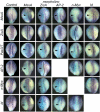Dissecting early regulatory relationships in the lamprey neural crest gene network
- PMID: 19104059
- PMCID: PMC2629288
- DOI: 10.1073/pnas.0806009105
Dissecting early regulatory relationships in the lamprey neural crest gene network
Abstract
The neural crest, a multipotent embryonic cell type, originates at the border between neural and nonneural ectoderm. After neural tube closure, these cells undergo an epithelial-mesenchymal transition, migrate to precise, often distant locations, and differentiate into diverse derivatives. Analyses of expression and function of signaling and transcription factors in higher vertebrates has led to the proposal that a neural crest gene regulatory network (NC-GRN) orchestrates neural crest formation. Here, we interrogate the NC-GRN in the lamprey, taking advantage of its slow development and basal phylogenetic position to resolve early inductive events, 1 regulatory step at the time. To establish regulatory relationships at the neural plate border, we assess relative expression of 6 neural crest network genes and effects of individually perturbing each on the remaining 5. The results refine an upstream portion of the NC-GRN and reveal unexpected order and linkages therein; e.g., lamprey AP-2 appears to function early as a neural plate border rather than a neural crest specifier and in a pathway linked to MsxA but independent of ZicA. These findings provide an ancestral framework for performing comparative tests in higher vertebrates in which network linkages may be more difficult to resolve because of their rapid development.
Conflict of interest statement
The authors declare no conflict of interest.
Figures





References
-
- Hall BK, Hörstadius S. The Neural Crest. Oxford: Oxford Univ Press; 1988.
-
- Le Douarin NM, Kalcheim C. The Neural Crest. 2nd Ed. Cambridge, UK: Cambridge Univ Press; 1999.
-
- Monsoro-Burq AH, Wang E, Harland R. Msx1 and Pax3 cooperate to mediate FGF8 and WNT signals during Xenopus neural crest induction. Dev Cell. 2005;8:167–178. - PubMed
-
- Sato T, Sasai N, Sasai Y. Neural crest determination by coactivation of Pax3 and Zic1 genes in Xenopus ectoderm. Development. 2005;132:2355–2363. - PubMed
-
- Basch ML, Bronner-Fraser M, Garcia-Castro MI. Specification of the neural crest occurs during gastrulation and requires Pax7. Nature. 2006;441:218–222. - PubMed
Publication types
MeSH terms
Substances
Grants and funding
LinkOut - more resources
Full Text Sources
Other Literature Sources
Molecular Biology Databases
Research Materials
Miscellaneous

